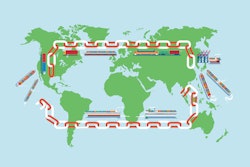
As expected, bans on Russian oil and gas exports are affecting the global economy in significant ways. Crude oil supply has tightened drastically, as nations have closed their borders to Russian energy imports. Canada led the charge when the country announced a ban on Russian oil imports on February 28. The U.S. followed suit with an executive order on March 8 and has since taken steps to pass formal legislation that would keep Russian crude, gas, coal and related products out of the country. The UK, Switzerland and EU more broadly have pursued similar actions.
While these sanctions serve an important purpose, they are creating challenges for domestic energy companies and consumers. Organizations in the energy sector are struggling to manage their supply chains effectively once again after two tough years. Supply and demand variability, coupled with the ongoing consequences of the COVID-19 pandemic, are making it difficult for energy supply chains to find stable ground.
Meanwhile, gasoline prices in the U.S. broke a record set in 2008 when the average national cost for a gallon rose above $4.00 in March and at the time of writing edges ever closer to $5.00. Prices are likely to remain high for the time being, especially given Russia’s current standing as a major global energy producer.
Amidst the chaos, energy companies must find ways to survive and meet consumer needs. Supply chain professionals, specifically, must take matters into their own hands rather than wait for a resolution to the Russia-Ukraine war. But what exactly can leaders do to combat inflation, supply volatility, and greater uncertainty? The answer lies in making supply chains more agile and resilient by increasing operational visibility.
The importance of supply chain visibility
Our supply chains have grown increasingly complex in the last 50 years, when offshoring began - U.S. companies have moved much of their activity overseas in hope of reducing costs and leveraging comparative advantages. It’s well-known that international producers are often more cost-effective, even after accounting for shipping times and distribution expenses.
However, overseas producers and suppliers have their own networks and dependencies as well. This creates a complex, convoluted web of relationships that determines how goods get from one side of the world to another.
As part of this supply chain globalization, leaders have lost some control over their end-to-end supply chains. Executives today must trust external partners, for better or worse, to fulfill service obligations without knowing how things are done on the ground. In other words, prioritizing access to specialization over absolute transparency into day-to-day activity.
The modern oil and gas industry is certainly affected by these dynamics and how extensive partner networks have become over the past several decades. Many American energy companies rely on imports from overseas producers to serve domestic customers, which is why the Russian sanctions are having a material effect on our supply chains.
To mitigate the downsides of these sanctions, energy supply chain managers need more visibility across their operational footprints. They need access to real-time information about where supply exists and how demand is changing across every market. Only then can supply chain leaders make the best decisions for their businesses.
How visibility helps overcome supply and demand variability
Improving visibility makes it easier to navigate disruption, even relatively planned disruptions like economic and political sanctions. When supply chain leaders know more about what external partners are dealing with and where supply networks are backed up, they can respond proactively. Visibility also enables transparency, which is more about understanding the context behind the outcomes we observe. Put simply, visibility describes what’s happening, and transparency explains why.
When supply and demand are in flux, like they are now, visibility and transparency are empowering. Supply chain leaders don’t have to speculate as much about available inventory. They can collaborate more effectively with suppliers and come up with alternative solutions to complicated problems. When supply and demand variability ramps up, they can adjust how products are distributed across their service areas and maintain revenue stability.
We’ve seen the benefits of increased visibility in the pandemic recovery. Brands that had more insight into their supply chains were able to pivot faster when needed. They had a better understanding of on-hand materials, capacity and orders, allowing them to mitigate risk more easily. And they had more flexibility to pursue alternate (back-up) options.
These lessons from the COVID-19 pandemic can be transferred to the Russia-Ukraine war. The question, of course, is how to go about improving visibility. Fortunately, there is a solution—invest in a digital supply chain planning solution.
An antidote for uncertain times
Supply chains have for too long relied on analog approaches to sharing information. Spreadsheets, emails, phone calls, and physical documentation are how teams have distributed operational data for years. But with modern technology, we can digitize these recordkeeping methods and extend real-time insights and accessibility to those who need it, including external partners.
When critical information exists in one place, everyone is better informed and capable of problem-solving in challenging times. Executives can plan better and respond quickly to unanticipated challenges. Applying this to the current oil and gas situation, a shared supply chain planning platform would enable energy companies to plug supply gaps and absorb disruption upstream, midstream and downstream. In doing so, they boost supply chain resilience, which is essential in uncertain times.
Now more than ever, it’s clear that disruption can surface anywhere, at any time. In our interconnected world, few global energy companies are unaffected by what’s happening in Russia and Ukraine. That’s why we must rethink how we approach our supply chains going forward.
We need better visibility to boost agility and resilience—the best way to enable this visibility is through digital platforms that consolidate data and democratize its access. The right solution can minimize the impact of sanctions on energy products and help companies get through this disruptive environment successfully.














